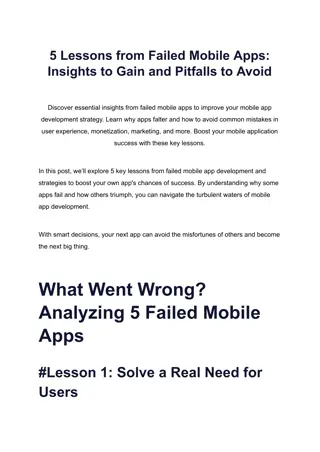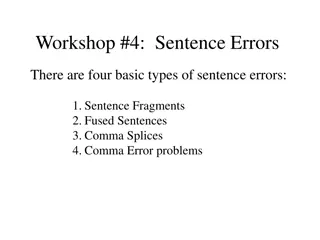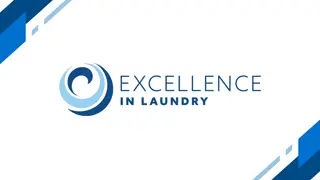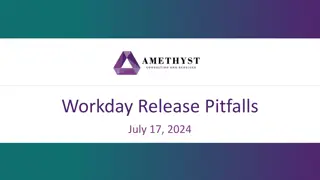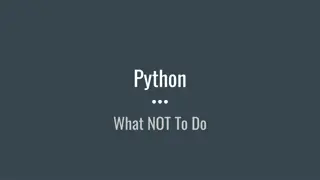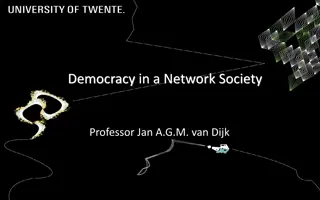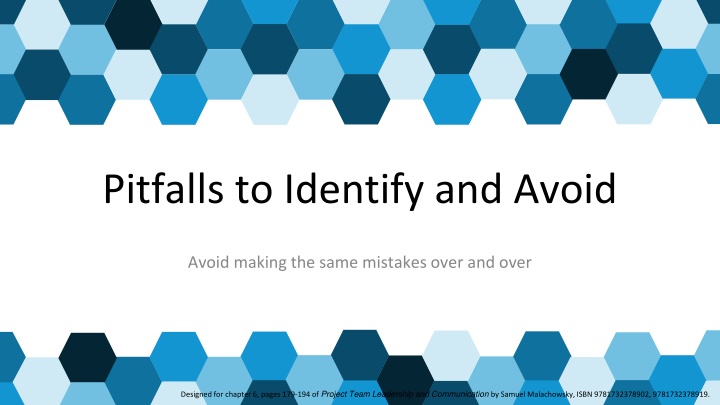
Identify and Avoid Common Project Pitfalls
Learn about common pitfalls that can occur in project management, such as blamestorming, blowhard jamboree, and groupthink. Understand the negative effects of these pitfalls and how to fix them by focusing on facts, encouraging a culture of learning from mistakes, and seeking quality information.
Download Presentation

Please find below an Image/Link to download the presentation.
The content on the website is provided AS IS for your information and personal use only. It may not be sold, licensed, or shared on other websites without obtaining consent from the author. If you encounter any issues during the download, it is possible that the publisher has removed the file from their server.
You are allowed to download the files provided on this website for personal or commercial use, subject to the condition that they are used lawfully. All files are the property of their respective owners.
The content on the website is provided AS IS for your information and personal use only. It may not be sold, licensed, or shared on other websites without obtaining consent from the author.
E N D
Presentation Transcript
Pitfalls to Identify and Avoid Avoid making the same mistakes over and over Designed for chapter 6, pages 179-194 of Project Team Leadership and Communication by Samuel Malachowsky, ISBN 9781732378902, 9781732378919.
Common Project Pitfalls Common project mistakes are avoidable if identified early Also known as antipatterns common issues often caused by those experiencing them Pitfalls can occur at any time throughout the project, but their negative effects are often felt significantly downstream Individual industries or organizations have their own common pitfalls Two categories covered here: Team Pitfalls (Blamestorming, Blowhard Jamboree, Groupthink, Heroics, Intellectual Violence, Loose Cannon, Poor Project Team/Stakeholder Relations, and Wishful Thinking) Process and Product Pitfalls (Analysis Paralysis, Death March, Fire Drill, Ineffectively Adding Resources to the Team, Rushing to Execution, Scope Creep, and Silver Bullet) Awareness is key
Team Pitfall: Blamestorming Team members spend excess time analyzing and admiring the problem rather than productively working to find a solution. Has the tone of an inquisition. Blame and responsibility become more important than the issue itself Team members are afraid to make (and learn from) mistakes External pressures such as a difficult stakeholder or missed deadline can be a factor Related: scapegoating, witch-hunt, cover-your-rear mentality The Fix: Measurements of progress should be based on facts rather than opinion Focus on the most important issues (and the actions needed to resolve them) first Encourage a culture of learning from mistakes rather than hiding them
Team Pitfall: Blowhard Jamboree Opinions, misinformation, or bias are often shared as facts, improperly influencing important decisions (planning, estimates, etc.) Can be unintentional: confirmation bias or poor sources of information Can be intentional: intentionally influencing important decisions for personal benefit The Fix: Honesty about why you have an opinion Spend additional time analyzing problems and potential solutions Seek better quality information: specialists, fact-based sources Brown, William J., Malveau, Raphael C., McCormick, Hays W., Mowbray, Thomas J. Anti-Patterns - Refactoring software, architectures, and projects in crisis. John Wiley & Sons. p. 214. 1998.
Team Pitfall: Groupthink Teams value harmony and conformity over diversity of though, leading to less creative decision-making and opposing viewpoints Making a decision as a group generally is beneficial because of diversity; groupthink erases that benefit, leading to wasted time for more individuals Can be caused by a fear of conflict, which can emerge from debate A strong, central leader can cause team members to hesitate in showing opposing viewpoints The Fix: Split the group into sub-groups, who discuss topics independently then recombine Use a meeting coordinator rather than the boss If needed, assign a devil s advocate to introduce opposing viewpoints Whyte, W. H., Jr. "Groupthink". Fortune. p. 114 117, 142, 146. March 1952.
Team Pitfall: Heroics In spite of all obstacles (lack of time or resources, poor planning, etc.), a few heroes push to complete the project Team members who have a realistic view of the project may be seen as pessimists or non-believers Heroes often are left feeling overworked and underappreciated, opting to leave The Fix: Most important is a realistic view of schedules, resources, and what can be accomplished. Accuracy (not optimism) in estimating should be valued A sustainable pace is an important organizational value constant panic mode can lead to high resource turnover
Team Pitfall: Intellectual Violence One party understands a theory, technology, or jargon, and uses this knowledge to intimidate or subjugate others in public or a meeting Fear of not knowing something can cause a more closed, less collaborative environment Can happen inadvertently and often stifles creativity within the team The Fix: Team leaders should monitor for intellectual violence continuously, including their own behavior Teams must embrace mentorship instead of defensiveness Brown, William J., Malveau, Raphael C., McCormick, Hays W., Mowbray, Thomas J. Anti-Patterns - Refactoring software, architectures, and projects in crisis. John Wiley & Sons. p. 243. 1998.
Team Pitfall: Loose Cannon A single member of the team constantly causes disruption within the team environment affecting the outcomes the team is working towards Can be exasperated by tight deadlines, limited resources, or difficult work Loose cannons often prioritize workplace politics above substantive work May have long-term effects such as degrading stakeholder relations or team members leaving rather than continue to work with the loose cannon The Fix: Personal attention by the team leader (mentoring, one-on-one time) may help address the individual causes directly Isolation (work from home, separate office location) or termination of the loose cannon may become necessary
Team Pitfall: Poor Project Team/Stakeholder Relations Poor relations between individual stakeholders (the customer, other teams, etc.) can have a significant impact on the viability of any project Different agendas, motivators, influencers, and personality types can cause friction Contract negotiation, financial risk, and market forces can exasperate the situation The Fix: Limiting contact, such as having one point person for each group can be effective, especially if conflicting information is coming from multiple sources Eliminating stressors by engaging in appropriate planning and risk management can be effective Consistent, clear communication is key
Team Pitfall: Wishful Thinking Optimism, uncertainty, or ignorance can lead to inappropriate assumptions and poor decision making by project leaders and team members Can lead to insufficient planning, ignored risks, and overly optimistic schedules Often includes assumptions that outsourced/contracted work will be delivered on time and with sufficient attention to quality Regressive renegotiation can lead teams to promise an expanded scope in exchange for an extended deadline, leaving the project even further behind The Fix: Schedules and risk scenarios should be considered carefully when creating schedules If the team tends to avoid negativity, they may also fail to consider legitimate issues
Process/Product Pitfall: Analysis Paralysis Teams demonstrate reluctance in moving out of the early/planning stages of a project into implementation Often caused by the fear of failure, unclear channels of accountability, micromanagement, or a problem which has no apparent solution Death by planning, an overly complex plan can increase projects costs significantly Too much time spent in early stages can cause schedule pressure later on The Fix: An incremental/cyclical process allows the team to plan/implement a bit at a time Creating and demonstrating prototypes can alleviate the risk of early missteps Leaders and teams must be willing to learn from failure (a non-operational mindset) Brown, William J., Malveau, Raphael C., McCormick, Hays W., Mowbray, Thomas J. Anti-Patterns - Refactoring software, architectures, and projects in crisis. John Wiley & Sons. p. 215-219. 1998.
Process/Product Pitfall: Death March Projects in a death march are destined to fail and everyone knowns it, but the ones who can remedy the situation are unaware or unwilling to take action An unattainable goal, unreasonable deadline, or insufficient budget are causes Can have a devastating effect on team member morale and retention, especially long-term The Fix: Avoid committing to schedules and budgets before initial planning and estimates are completed Increase scheduling, budget, and tracking visibility to management Be sure to properly reward team members who have stuck it out or risk them leaving Yourdon, Edward. Death March: The Complete Software Developer s Guide to Surviving Mission Impossible Projects. Prentice Hall. 1999.
Process/Product Pitfall: Fire Drill Fire drills are characterized by constantly shifting priorities and a disorganized, reactive project environment Can be caused by poor leadership ambiguous or constantly shifting goals, or a hesitation to begin or commit to a course of action Some team members prefer a fire drill environment because it can mask poor quality work or lack of individual productivity The Fix: One effective strategy is project management sheltering, where the team leader personally acts as a single liaison with the outside world, working to create a consistent, evenly-prioritized work environment for the team Eliminating the circumstances that lead to fire drills is the best fix Brown, William J., Malveau, Raphael C., McCormick, Hays W., Mowbray, Thomas J. Anti-Patterns - Refactoring software, architectures, and projects in crisis. John Wiley & Sons. p. 262-264. 1998.
Process/Product Pitfall: Ineffectively Adding Resources to the Team Adding resources who don t have proper skills/training or who are ineffectively managed can result in less productivity than expected Teams that hire external contractors often don t manage them effectively Adding people to an already late project hoping to catch up can leave the team even further behind Group work can introduce the opportunity for social loafing, allowing individuals to expend less effort (without being noticed) than if they worked alone The Fix: Understand that introducing new team members will require a large initial commitment and effort before gains are realized Engage current team members in bringing new ones up to speed Brooks, Frederick P., Jr. The Mythical Man-Month. Addison-Wesley. 1975. Latane, B., Williams, K., and Harkins, S. Many Hands Make Light the Work: The Causes and Consequences of Social Loafing. Journal of Personality and Social Psychology, 37(6), p. 822-832.1979.
Process/Product Pitfall: Rushing to Execution Attempting to show real progress sooner, the project spends less time in the initiation and planning phases so that they can enter the execution phase sooner Early project phases require more discipline, forethought, and may bring more pressure from the customer or management who have less visibility of progress Upstream activities such as design iterations, thorough estimation, risk management, and formal approval/signoff are often skipped, leading to issues downstream The Fix: Properly consider early project activities, giving early achievements recognition similar to those in the execution phase Retrospectives and lessons learned from previous projects will often call for increased early-project efforts (planning, estimation, stakeholder analysis, etc.)
Process/Product Pitfall: Scope Creep As the project progresses, new requirements/specifications are slowly added. Eventually, this has a major cumulative effect on the schedule or resources. Additional scope is just as likely to be added by the team as by the customer or other stakeholders Shortchanging upstream activities such as writing a scope statement or detailed specifications increases the likelihood of scope creep The Fix: Implement strong change management controls such as signoff for scope changes Iterative or incremental (agile) methods allow for and even expect requirements/ specifications changes throughout the project. Consider implementing them if needed
Process/Product Pitfall: Silver Bullet A new tool, technology, technique, or process is thought to have a magical effect on projects. May be caused by marketing hype, previous success, or wishful thinking Can lead to poor performance or unrealistic estimates, ultimately leading to projects that are behind schedule The Fix: Manage opportunities like risks, carefully considering their chance of occurring as well as realistically analyzing their potential impact When introducing new tools, products, or processes, understand that adoption of new ideas takes time, possibly more than might be saved
Pitfall Hot Spots Pitfalls often occur during an early phase, causing negative consequences at later phases Selected Examples: Initiation Phase Planning Phase Execution Phase Closing Phase Group Think Could hamper ability to explore problems and find root causes Could result in less creative designs and solutions Verification or testing efforts may fail to con- sider diverse scenarios Analysis Paralysis Analysis paralysis happens mostly during this phase Paralysis may continue here, as the team is reluctant to get started Late delivery and missed deadlines are the most common consequences of this early- project problem Silver Bullet A new tool, technology, or technique is pro- posed, and too little research or inflated expectations affect the project s schedule Difficulties are encountered, and the silver bullet is revealed to be less productive than expected Ultimately, the delivery date and/or budget is impacted Malachowsky, Samuel. Project Team Leadership and Communication. LintwoodPress. 2018. p. 188-191.
Summary and Conclusions Consistently avoiding pitfalls requires the following: An awareness of both what can happen and when it s most likely to occur Diligence and continuous introspection Management and leadership support A deliberate culture shift within the team and organization It s important to understand and consider the downstream effects that actions that a leader or team s actions and decisions can create.







